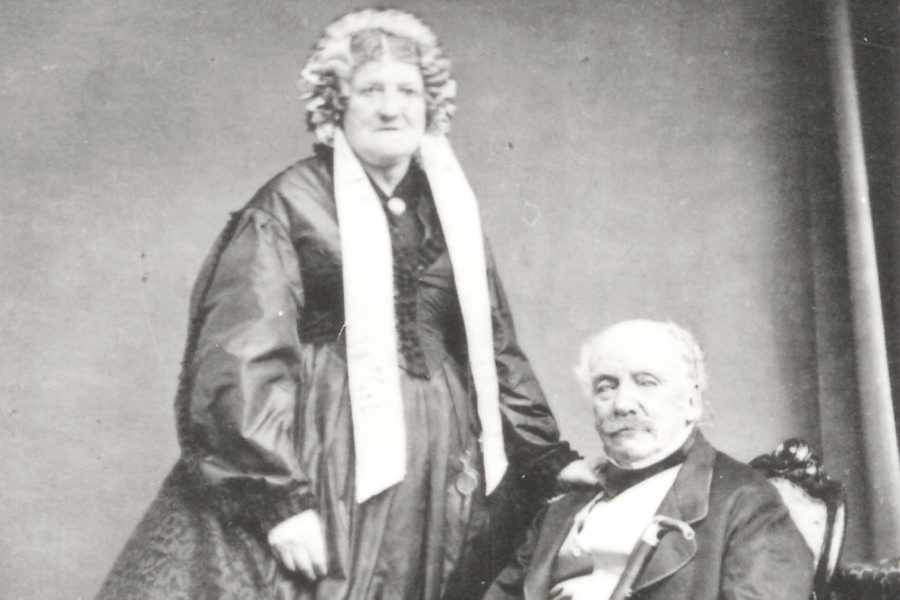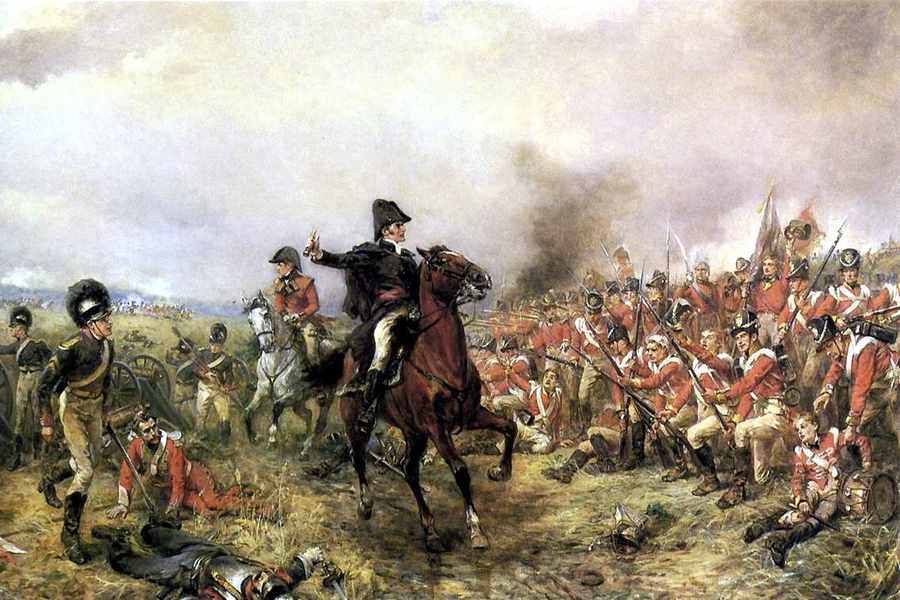
The only Jerseyman known to have fought at Waterloo was Captain Henry Dumaresq.
However, Jersey has the highest concentration of graves of Waterloo and Peninsular Campaign veterans compared to population size of any place in the world due to the number of military families who settled here in the 19th century.
Jersey Heritage’s commercial director, Jeremy Swetenham said: ‘We’ve got a big focus on family history this year, both for Jersey families and those Jersey names that have gone far and wide abroad, and also for families who moved to the Island.
‘A significant section of the English community in Jersey during the 19th century was mainly retired officers and soldiers, so it’s an opportunity to see if we can find some of the descendants of Waterloo families in time for June.’
The families Jersey Heritage would like to hear from are Campbell, Stewart, Louis, Day, Dixon, Sinclair, Simmons, Henegan and Gibbs.
They will be invited to a gathering of the families in June to celebrate the anniversary.
Descendants of Waterloo veterans can contact Jeremy.Swetenham@JerseyHeritage.org for more information.

ON Monday 19 June 1815 the soldiers of Wellington’s victorious army woke up to a new world. During the battle of Waterloo, 45,000 men were killed and wounded and a further 20,000 were missing. The remains of the French army fell back towards Paris and within a fortnight the French finally surrendered, bringing to an end nearly 22 years of warfare.
The British Army stood at just under 234,000 men. Crippled by debt, the British government saw the opportunity to save money by reducing its military spending: within five years it fell from £43 million to £10.7 million. This was achieved by demobilising men, but many officers, many of whom had bought their commissions, had to be put on the half-pay list. For those half-pay officers without a private income, Jersey, with its low cost of living, seemed an ideal place to retire.
Doug Ford of Jersey Heritage takes up the story: ‘This influx of the English middle classes resulted in a new trend of architecture emerging in the Island reminiscent of the late Georgian and Regency styles that were to be found in English county towns.

‘The Island was also experiencing something of a post-war boom with a growing cod trade, shipbuilding, oyster trade and a number of capital developments.
‘By 1831 the population of the Island had risen to 36,582, of whom just under 4,500 were immigrants. By 1841, 24 per cent of the population had been born in the UK. The anglicisation of the Island was beginning. In 1834 the States adopted an English-style currency, and changes to the political system were gradually introduced.
‘In the years that followed, Waterloo became associated with this brave new world and men who had played their part on that day in June 1815 gradually assumed positions of power.
‘Wellington himself entered politics as a Tory cabinet minister and twice served as Prime Minister, and in 1821 Sir Colin Halkett, commander of the 5th Brigade, became the first to reside in Government House on St Saviour’s Hill when he was appointed Lieutenant-Governor of Jersey.
‘The Waterloo campaign was the first for which the authorities issued a medal to all ranks who had fought in it. Altogether, 39,000 medals were issued.

‘The only Jerseyman present at Waterloo that we know about was Captain Henry Dumaresq (1788-1838) of the 9th Regiment of Foot, who was acting as ADC to Major General Sir John Byng, commander of the 2nd Guards Brigade at Quatre Bras.
‘Despite being severely wounded at Houguemont, he was dispatched with a message to Wellington which he delivered before falling from his horse, having been shot through the lung.
‘He continued in the Army after the Treaty of Vienna and ended up Lieutenant-Colonel of the 9th Regiment.
‘In August 1828 he married Elizabeth Sophia Butter Danvers in St George’s Church, Hanover Square, London. The couple moved to Australia in 1834.
‘About 25,000 British troops were present at Waterloo. Of course, the men mentioned here are all drawn from the officer class, as these are the men we know most about: the real challenge lies in determining how many of the rank and file, the majority of the fighting men at Waterloo, came to the Island to work in the oyster trade, the shipyards or on the construction sites.’
THE Waterloo veterans who moved to the Island in the early 19th century were:
Lieutenant Archibald Stewart
1st lieutenant in the Company of 1/95th (Rifles). In 1818 he was made Captain and 1829 he was a Major. He was put on the half-pay list in 1835.
Three years earlier he had borrowed £500 from a Miss Ann Goddard against a property in Edinburgh. When he died, the sum was still outstanding and Miss Goddard took his estate to court in Scotland. It is only through the judgment in 1844 that it emerged that he had married Eliza Cross and that the couple had children.
Eliza died in Jersey in 1838 and there was at least one son, John Stewart. He died in June 1836 and is buried in St Saviour.
Captain Charles Cadell (1786-1866)
Born in East Lothian, Scotland, was a captain in the 28th Foot serving in the 5th British Infantry Division, in the bloodiest part of the action. He took over command of the regiment when all the senior officers were either killed or wounded.
He was placed on the half-pay list in 1833. By 1851 he and his wife Isabella Caroline were living in Jersey at Richmond Villa, Clarendon Road, and in 1861 they lived at Inkerman Place, Almorah Road.
Lieutenant George Simmons (1785-1858)
Born in East Yorkshire, was a Lieutenant in the 1/95th (Rifles) Regiment. He was shot through the liver, took a bullet in the chest and had two ribs broken.
In 1834 he married Ann Corbet Le Breton, daughter of Sir Thomas Le Breton, the
former the Bailiff of Jersey (her cousin, William Corbet Le Breton, was the father of Lillie Langtry).
By the 1840s the family were living in Grosvenor Terrace. The couple had three children, Ann Corbet (1837-1919, born in Greenwich), Frances Eliza (1839-1933, born in Jersey) and George Le Breton (1842-1869, born in Jersey).
Captain James Frederick Love (1789-1866)
Captain in 1/52nd Regiment of Foot, the largest battalion on the battlefield. He was severely wounded four times. In 1825 he married Mary Heavyside. He was Lieutenant-Governor of Jersey from 1852-57.

THE following are other Waterloo veterans who moved to the Island in order of surname occurrence in the current Jersey population (* denotes many potential JEP readers with the same surname):
2nd Lieutenant Richard Goodwin Bowen Wilson (1796-1876)*
In the 5th Division of the Reserves. Following the battle he was promoted to 1st Lieutenant. His wife, Marguerite or Mary Anne, was born in Jamaica in about 1798. They had at least one son, Colonel Sylvester Frederick William Moor Wilson, born in Gibraltar in 1828. Richard died in October 1876 at home, Floriana, Beaumont, and was buried in St Saviour’s Churchyard.
Lieutenant Norman Campbell (1787 -1836)*
Of the 71st Foot Regiment, he served in the 2nd British Infantry Division. He was put on the half-pay list in 1818. He died in St Helier.
Lieutenant James Day*
Lieutenant in ‘A’ (Lieutenant Colonel Ross’s) troop of the Royal Horse Artillery. On the day of the battle they were part of the British Reserve Artillery under the direct command of Wellington.
He was promoted to Captain in November 1927 and he was put on the half-pay list in February 1828. He died in Jersey in August 1843.
Lieutenant Francis Dixon
Lieutenant in Captain MacNamara’s Company in the 2/95th (Rifles) Regiment. He was put on the half-pay list in 1817. He died on 30 October 1832 and is buried in St Saviour’s Churchyard.
James Sinclair (1783-1851)
He was 2nd Captain in the Company of Royal Horse Artillery, and was part of the 6th Division under the direct command of the Duke of Wellington. After the end of the war he spent some time as commanding officer of Elizabeth Castle. He retired on full pay in late 1841. He died in his home Windsor Lodge, Val Plaisant in May 1851.
Intriguingly, the census taken a few weeks earlier shows him as having a 23-year-old Irish wife entered on the form simply as Mrs Sinclair, who was left nothing in his will. However, he did leave £500 and the furniture from his house in Jersey to his good friend Mary Condon and £30 to her sister Helen Condon, who was one of his servants.
Lieutenant Frederick Beattie
Lieutenant in the 7th Hussars, who were on the extreme right of the allied line, about 300 yards north of Houguemont. Beattie was severely wounded. He died in Jersey in 1853.
Lieutenant Matthew Louis
A Lieutenant in ‘I’ (Major Bull’s) Troop of Royal Horse Artillery. In 1825 he married Mary Mollock of Cockington Court and continued his career in the Royal Artillery. He retired as a Lieutenant Colonel on full pay in April 1852 and moved to Jersey, only to die the following year.
Richard D Henegan (1782-1872)
THE following are other Waterloo veterans who moved to the Island where no surnames occur in the current Jersey population:
Captain John Robert Budgen (1791–1866)
Started the campaign as a Lieutenant in Captain Logan’s Company in the 2/95th (Rifles) Regiment. On 23 January 1823 he married Williamza Caroline Mary Moore. By 1829 they had two children. He died in 1866 and his wife died in 1870. They are both buried in St Martin.
Lieutenant Frederick Mainwaring (1796-1858)
Born in Surrey, he was a Lieutenant in Captain James Phelps’ Company of 51st Regiment of Light Infantry. He married Catherine Sarah Dowson Popham in Yorkshire in 1826.






